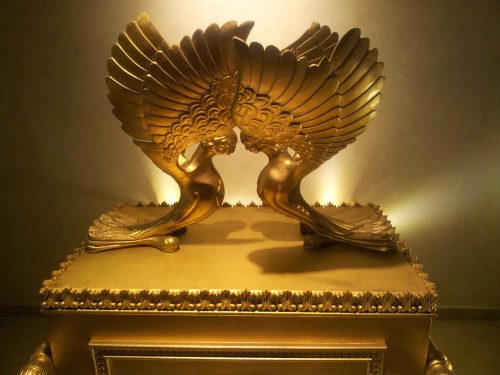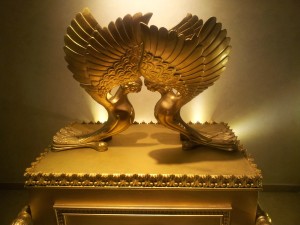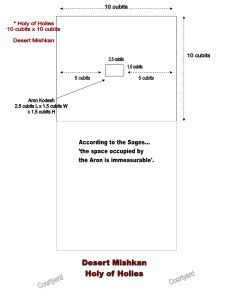
01 Feb Parshas Terumah – Mystical Insights of the Mishkan (r.5783)
by Leib Getzel (Lawrence) Lax
Inspired by the teachings of Harav Yitzchak Ginsburgh and Rabbi Moshe Genuth
Mystical insights into the Mishkan
The Power of the Paradox of the Infinite and the Finite
The Parshas of the Mishkan are always read around the time of Purim. There is a shared concept between them of G-d concealed and G-d revealed.
The mishkan, and especially the Aron, is a vessel through which G-d reveals Himself from the realm of the infinite to the realm of the finite. In the chag of Purim and the Megilas Esther, G-d seems to be concealed as Hashem’s name does not appear in writing in the Megilas Esther, but on more profound level, He is always present.
The Mishkan is metaphor of creation itself. This physical world is the world of Tikun-Rectfication, a world whose elevation and perfection is dependent on symmetry. This is a concept based on the symmetry of both G-ds masculine and feminine attributes as they exist both inside and outside time and space, sometimes referred to as the 2 dimensional spiritual world and manifest as the 3 dimensional physical world.
This world is a world of paradox. Just as we understand that a paradox is inherent in all aspects of this universe, so too we must understand that this is a result of a universe that is both physical and spiritual which exists and is sustained by G-d Who is both inside and outside time and space as we understand it. In order for us to relate to Him, we must do so from this world ( the world we refer to as inside time and space), the World of Rectification (Tikun).
It is through mitzvot and tefillah (prayer) with a connection of our mind and heart that we are able to transcend this physical world and bring into this world more of G-d’s Infinite Light. When we achieve this connection in a rectified way we enter into a powerful relationship with G-d and can cause a tikun (rectification) to occur. The ultimate rectification (through our tshuvah) that we can achieve in this world is the bringing of Mashiach, the Final Redemption.
There is an understanding that to have a truly connecting experience to G-d, to be able to access G-ds abundant light, a person must (as we say) ‘be in the paradox… be holding 2 opposites, or in other words ‘be standing in the question’. It is here, in this state of mind, that one achieves the greatest connection. The connection is acquired not in the total and complete resolve of the question or paradox as total perfection impossible in this world, but the merit is achieved in the process is the resolve.
We can refer to the Sages Shemai and Hillel, as it was in their ‘arguments for the sake of Heaven’ that brought them (and consequently through their teachings for all of us) closer to G-d. They held opposing ideas, each of them true. It was in there arguments that they brought opposing, or paradoxical ideas closer together and thus revealing a greater truth.
The World of Tohu- Chaos and The World of Rectification came to be as a result of a tikun (rectification) from the World of Tohu (Chaos). The World of Chaos was made up of many unrectified worlds (or kingdoms). These worlds did not interact with one another and remained autonomous, or independent of one another, thus the name applies to the World(s) of Chaos. It is when one single world availed itself by nullifying itself to an external presence, another entity (or world), that that World (from Chaos) became rectified, giving ‘birth’ to this world, the World of Rectification. This was very much like human procreation. The process of nullification thus allowed another presence (the presence of 2 worlds) to interact in the process of feminine and masculine energies interacting in a procreative process. The time duration of the stages of procreation and the growth process here as in all aspects of life may vary.
The growth or change process may be ‘evolutionary’ (as a slower process of growth), or it may be ‘transformative’ (as rapid change in growth). In the example of the World of Chaos and the World of Rectification, the Creation of this world is the progeny of that union as we have said, the union of a single world nullifying to another entity, or an interaction of masculine and feminine energies. All of creation works through the model of masculine-feminine interaction in an infinite series of ‘births and rebirths’. Chassidut refers to the ‘pre-interaction phase’ as the period of Submission; a state of bitul or nullification (acquired through the trait of humility). This submission phase is followed by the periods of Separation and Sweetening, a process referred to as Chash-Mal-Mal (Submission – Separation – and Sweetening) [Baal Shem Tov].
We will now look at the mystical energies of the tabernacle and how the dimensions of the physical and spiritual worlds are paradoxical and harmonious simultaneously.
The Cherubim, the Menorah, and Male-Female Symmetry.
There exists male symmetry and female symmetry of the Cherubim and the Menorah. At a very simple level, the world can be broken down into masculine and feminine spiritual energies. Evolutionary and transformative changes that take place are as result of these interactive and inter-inclusive associations.
*The two vessels in the Temple that reflect perfect symmetry are the Menorah and the Cherubim. The Menorah’s symmetry is relatively male (7 lights; 7 being an odd number is primarily masculine), while the symmetry of the cherubim is relatively female (2 cherubim; 2 being an even number is primarily feminine). (NB; the number 1 is neither masculine nor feminine).
In the Holy Temple, the male-symmetrical menorah is positioned in the holy sanctuary. The female-symmetrical cherubim are located in the Holy of Holies. The epitome of beauty and the symmetry of coupling is feminine, as also represented by the powers of ’2′ (as in 2 squared; 2²) associated with the cherubim.
The Symbol of Consummate Love between God and Israel
The Torah portion of Terumah discusses the details of the Sanctuary in which God dwells. The first vessel related to in detail in our portion is the Ark of the Covenant, above which are the two cherubim. While the Holy Ark contains the Torah–God’s eternal wisdom–His voice and ongoing directives emanate from between the joined wingtips of the two cherubim, who symbolize the consummate love of delights between God and the people of Israel.
Cherubim and the Powers of 2 (2, 2², 2³ );
As we have said, 2 is feminine and represents the power to receive. The root of the Hebrew word for the cherubim, kuf-reish-beit also represents 2. The numerical value of the kuf is 20, of the reish 200 and of the beit 2. All of these numbers can be reduced to 2 (in accordance with Gematria).
The 2′s represent the perfect state of love, harmony and delight symbolized by the cherubim. This love serves as the magnet that draws down God’s voice to speak to Israel.
In the Torah, the cherubim are initially referred to as 2. Each cherub had 4 elements or 2² (2 squared). The 4 parts defined as follows;
1. A Body
2. A Face
3. Right Wing
4. Left Wing
The first cherub is therefore equal to 4 elements or 2²(2 squared). When joined together at their wingtips, the cherubim have a total of 8 elements or 2³ (2 cubed).
*From summary notes Parsha Terumah-Harav Yitzchak Ginsburgh- Gal Einai
It is through the wings of the cherubim that G-ds voice is heard. The numbers of 2 as we have said represents symmetry of the feminine. We can further see that 2² and 2³ are also significant. The 2² corresponds to the 2 dimensions of the spiritual world (as well as the symmetry and love) and the 2³ corresponds to the 3 dimensions of the physical world. It is from the spiritual world that the voice of G-d descends through the cherubim and is heard in the physical world.
There seems to be a discrepancy in the dimensions , ie a paradox in the measurements given for the Aron Kodesh and the Holy of Holies (nb. the Temple Holy of Holies dimension is 20 x 20 cubits whereas the traveling Mishkan Holy of Holies measured (10 x 10 cubits) ;
2 Examples of Paradoxical Dimensions;
The Talmud (Yoma 21a) teaches us that (1) the First Temple built by King Solomon has inner dimensions of the Holy of Holies 20 cubits x 20 cubits (a perfect square), and the Aron Kodesh is 2.5 cubits x 1.5 cubit (x 1.5 H). The measurement from one edge of the Aron to the curtain wall is 10 cubits. The measurement from the other side of the Aron is also 10 cubits. When we add in the dimension of the Aron of 2.5 cubits, and we get a total overall width of 22.5 cubits as an interior dimension of the Holy of Holies thereby seemingly contradicting the previous dimensions given of the interior length and width of 20 cubits x 20 cubits total. Again, the exterior dimension of the Holy of Holies always remains 20 cubits x 20 cubit.
Paradoxical Dimensions Parshas Terumah (Yoma 21a)
(2)The dimension for the Holy of Holies for the traveling or Desert Mishkan varies. The inner dimension of the Holy of Holies is 10 cubits x 10 cubits, and the dimensions of the Aron remain 2.5 cubit x 1.5 cubit (x 1.5 cubit H). The measurement from the edge of the curtain to each side edge of the Aron is 5 cubit. When we add the width dimension to this measurement we get a total overall interior dimension of 12.5 cubit.
However, the overall (external) dimension never changes (as written in the Torah). This principle effecting both of these examples is as according to the Sages…’the space occupied by the Aron is immeasurable’.
So, is the Aron Kodesh really there or not? The following will give an understanding to explain this phenomenon…
Peek-a-boo…
Is the Aron Kodesh inside the Holy of Holies or is it not?
The measured dimensions regarding the presence of the Aron in the Holy of Holies although seemingly contradictory (i.e. interior measurement of 20 cubits vs. interior measurement of 22.5 cubits, and a never varying overall dimension of 20 cubits, or the Desert Mishkan having interior measurement of 10 cubits vs. interior measurement of 12.5 cubits, and a never varying overall dimension of 10 cubits ) are correct. The Aron Kodesh is both inside this world, and outside of this world, or one could say it is both inside and outside time and space simultaneously. The Aron does not take up any space in the Holy of Holies. According to the Sages…’the space occupied by the Aron is immeasurable’.
The possessing of a body and a soul is itself a paradox. Our bodies are the physical vessel that houses our spiritual essence, our soul, thus allowing us navigate through this world so that we may use our free will to observe the mitzvoth, engage in prayer, and have a conscious awareness of G-d to serve Him. It is power contained within this paradoxical existence (a body and a soul in a single vessel) that give us the ability to transcend the physicality of our finite body of this world and allow us through our infinite spirit to access G-d’s infinite light and incorporate into our body and the world. We have the ability, as in the paradoxical example of the Mishkan in the Holy of Holies to be both in this finite world and the spiritual world… simultaneously. The Mishkan and all it includes is a conduit of G-ds abundant spiritual light… and so are each one of us.
please click on diagram to view larger image-
Leib Getzel (Lawrence) Lax
Addictions and Counseling (Hnrs)
www.LawrenceLax.com
lawrenceJlax@gmail.com

